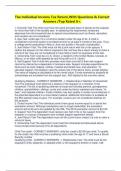The Individual Income Tax Return,With Questions & Correct
Answers /Top Rated A+.
1. Domicile Test The child must have the same principal place of abode as the taxpayer
for more than half of the taxable year. In satisfying this requirement, temporary
absences from the household due to special circumstances such as illness, education,
and vacation are not considered.
2. Age Test: under age 19 or a full-time student under the age of 24. A child is
considered a full-time student if enrolled full-time for at least 5 months of the year. Thus,
a college senior graduating in May or June can qualify in the year of graduation.
3. Joint Return Test: The child must not file a joint return with his or her spouse. If
neither the spouse nor the child is required to file, but they file a return merely to claim a
refund of tax, they are not considered to have filed a return for purposes of this test.
4. Citizenship Test: must be a U.S. citizen, a resident of the United States, Canada, or
Mexico, or an alien child adopted by and living with a U.S. citizen.
5. Self-Support Test A child who provides more than one-half of their own support
cannot be claimed as a dependent of someone else. Support includes expenditures for
items such as food, lodging, clothes, medical and dental care, and education. To
calculate support, the taxpayer uses the actual cost of the above items, except lodging.
The value of lodging is calculated at its fair rental value. Funds received by students as
scholarships are excluded from the support test., AGI highest is the one who claims
Qualifying Relative - CORRECT ANSWERS -1. Relationship or Member of Household
Test The individual must either be a relative of the taxpayer or a member of the
household. The list of qualifying relatives is broad and includes parents, grandparents,
children, grandchildren, siblings, aunts and uncles by blood, nephews and nieces, "in-
laws," and adopted children. Foster children may also qualify in certain circumstances. If
the potential dependent is a more distant relative, additional information is available at
the IRS website (www.irs.gov). For example, cousins are not considered relatives for
this purpose.
2. Gross Income Test The individual cannot have gross income equal to or above the
exemption amount. Although exemptions are no longer deductible, the exemption
amount will continue to be updated by the IRS. The 2018 exemption amount is $4,150.
3. Support Test The dependent must receive over half of his or her support from the
taxpayer or a group of taxpayers (see multiple support agreement below).
4. Joint Return Test The dependent must not file a joint return unless it is only to claim a
refund of taxes.
5. Citizenship Test The dependent must meet the citizenship test discussed above.
must provide social security # for all dependents
Child Tax credit - CORRECT ANSWERS -child tax credit is $2,000 per child. To qualify
for the credit, the child must be a qualifying child under the age of 17 and have a Social
Security number
Qualifying Child - CORRECT ANSWERS -1. Relationship Test: The child must be the
taxpayer's child, stepchild, or adopted child, or the taxpayer's brother or sister, half-
, brother or half-sister, or stepsibling, or a descendant of any of these. a foster child can
also qualify. must be younger than the person claiming him or her unless permanently
disabled.
Married filing separately - CORRECT ANSWERS -only if it reduces their total tax liability
both compute their tax the same so if one is itemized the other must be too
Charity Tax deductions - CORRECT ANSWERS -Can deduct cash contributions to
charity but not time or service but may also deduct mileage
Five basic tax reporting entities - CORRECT ANSWERS -individual, corporations,
partnerships, estates, trusts
What is considered taxable income? Form? - CORRECT ANSWERS -wages, salaries,
self employment earnings, rent, interest, and dividends
Form 1040
Form 1040 - CORRECT ANSWERS -For individual, has 6 schedules
1 Additional forms of income other than wages, interest, dividends, distributions from
qualified retirement plans such as IRAs and pensions, and Social Security benefits.
Schedule 1 also reports many of the deductions for adjusted gross income.
2 Additional taxes beyond the basic income tax such as the alternative minimum tax
and repayments of the advance premium tax credit.
3 Nonrefundable credits including education credits and the credit for child and
dependent care expenses.
4 Other taxes not included on Form 1040 and Schedule 2 such as self-employment
taxes, the nanny tax, and the individual responsibility payment under the Affordable
Care Act.
5 Payments besides withholding such as estimated payments, premium tax credit, and
excess Social Security taxes withheld.
6 Used for taxpayers with a foreign address or those wishing to allow a third-party
designee.
What is schedule A-F mean? - CORRECT ANSWERS -Schedule A: Itemized
deductions include medical expenses, certain taxes, certain interest, charitable
contributions, and other miscellaneous deductions
Schedule B: includes interest income and dividend income
Schedule C: Self-employment income from a trade or business, other than farm or
ranch activities, is included
Schedule D: capital gains or losses, he or she must generally report the details
Schedule E: supplemental income schedule, used to report rental or royalty income and
pass-through income from partnerships, S corporations, and estates and trusts.
Schedule F: Farm or ranch income
Taxpayers who use Schedules C, D, E or F will also report that same income on
Schedule 1




